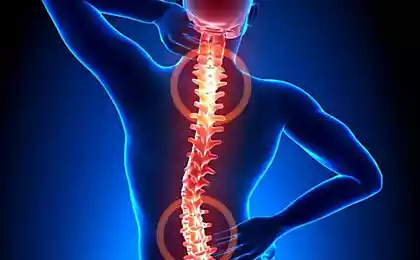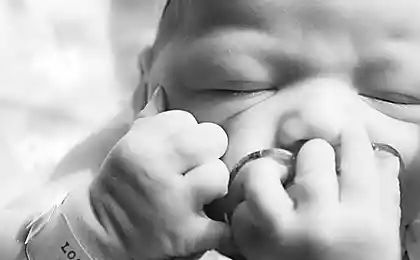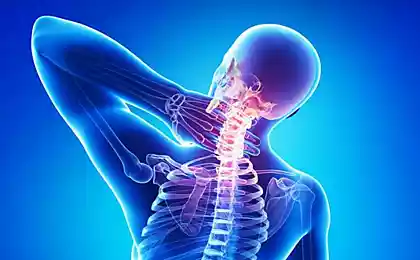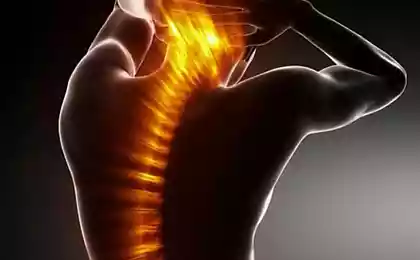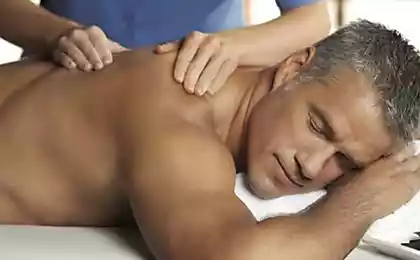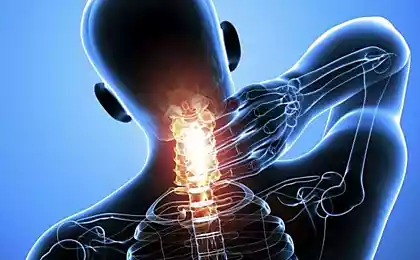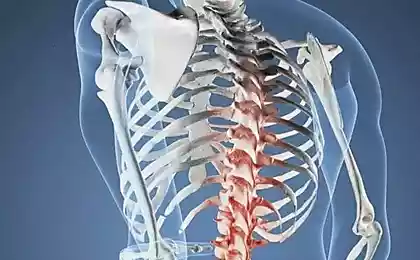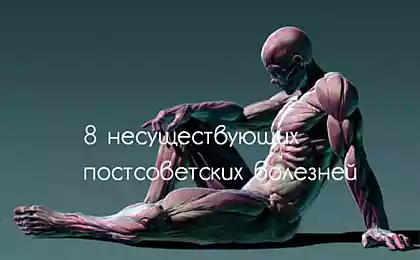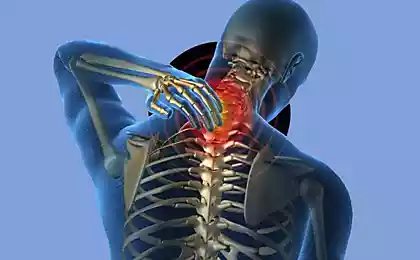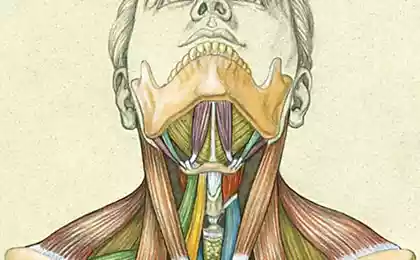1068
It is important to know! The main symptoms of cervical degenerative disc disease
Osteochondrosis of the cervical spine is dystrophic-degenerative disease of the intervertebral discs with subsequent defeat of the nearby bodies of the vertebrae, growths, spinal nerve roots, sympathetic plexus, muscles and fasciae of the neck, vessels carrying the blood supply of the stem part of the brain, of the shoulder girdle.This disease can cause narrowing of the spinal canal, compression of the spinal cord.
The intervertebral discs are unable to regeneratewith age because of violation of metabolic processes, physical overload, inappropriate movement patterns prematurely "wear out".

After 25 years purposee the core inside the annulus, begins involution, being replaced by fibro-cartilaginous tissue, and in the cervical region it is the fastest. Symptoms of cervical degenerative disc disease due to a violation of the integrity of the disc, prolapse nucleus pulposus, the presence of schmorl's nodule, osteophytes, irritation of their nerve plexus, blood vessels of the neck. Consider what are the symptoms of this disease in order of frequency of occurrence.
Cervical radiculopathy
Shooting pain neck and arms, associated with compression of a particular nerve root of the spinal cord. If the damage of the 5th cervical spine (CV), there is a sharp pain the neck, collarbone, outer side of the shoulder, deltoid muscle weakness, hyperesthesia outer surface of the shoulder.
The СVI compression of the spine causes pain in the neck, shoulders, outer surface of the shoulder, inner part of the forearm, thumb. Reduced pain sensitivity of this body part. Weakened tendon reflexes at the biceps. The defeat of the 7th spinal nerve root (СvII) causes pain in the neck, shoulders, back-the outer surface of the arm and forearm, index and middle fingers with the violation of the sensitivity of these areas.
Reduced reflex with crepaway muscles. Pain, sensitivity when СvIII compression of the spine occurs in the neck, and the radial side of the forearm, the little finger. Reduced supinatory reflex.
Scapulohumeral periarthrosis
Reflex pain syndrome, aggravation of cervical degenerative disc disease that occurs after hypothermia, trauma, lifting heavy weights. Complaints of pulling, burning, chilling back pain, anterior chest, between the shoulder blades, neck area, shoulder joint, shoulder. As a result of painful impulses appears protective contracture of the affected muscles of the shoulder, most often, external rotators and biceps.
The pain is worse at night, when movement of an arm, laying it under the back. In the long course of the disease may experience atrophy of the deltoid, supra - and podsticaj, the subscapularis muscles.
Hypoalgesia the outer surface of the shoulder. Over time, painful symptoms of nanoactuators a big chest, round muscles. However, not all painful motion in the shoulder joint. Jiggle your hand back and forth do not cause discomfort. Violation vegetatie manifested by edema, increase of the lividity of the brush (a symptom of Steinbrocker).
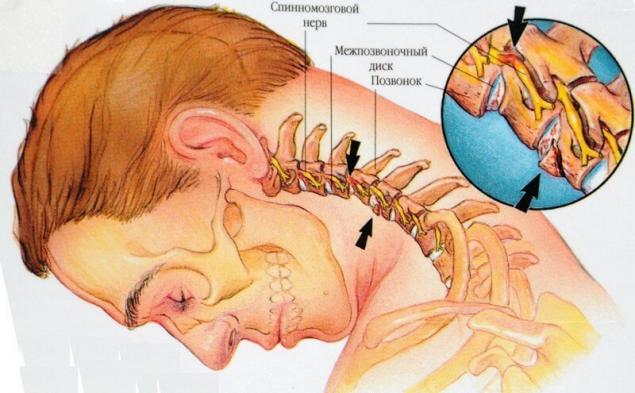
The syndrome of anterior scalene muscle
Reflex contracture of this muscle causes compression (compression) of the subclavian artery and brachial plexus. There is a soreness of the neck, particularly when rotating the head in a healthy way, which extends to the inner surface of shoulder, forearm and brush up to 4-th, 5-th fingers. People with this syndrome keeping your head slightly tilted forward toward the affected side. In the long there is atrophy of the hand muscles, paresthesia, with subsequent loss of sensation on the radial surface, weakening of the pulse at the radial artery. A deep breath intensifies the pain.
Syndrome spinal nerve
The back of the neck simpatolitiki syndrome ("cervical migraine"). Its appearance is connected with the presence of bone growths (osteophytes) processes of the hook joints of the cervical vertebrae. In humans, there is paroxysmal pain localized in the back of his head, smiling spreading to other parts of the skull. Typically the onset of symptoms in one side of the head.
The symptoms of disorders vertebrobasilar system
It develops mainly in people with atherosclerotic lesion of the vertebral arteries, a chronic increase in blood pressure. Dizziness, feeling short of breath, General weakness. With a sharp tilt or turn of the head you may experience a brief loss of consciousness, derealization, impaired orientation, stuffy ears. If, because of impaired circulation suffer stem parts of the brain, appears tingling, burning of tongue, throat.
Symptom of vertebral artery – vestibular violations of statics, coordination, gait. There is intolerance of sound and light, nausea, palpitations, heart pain. Optic, oculomotor disorders is the deterioration of visual acuity, narrowing and loss of visual fields, diplopia.
Cervical discogenic myelopathy
Schmorl's nodule reduce the sagittal diameter of the spinal canal. Is spinal cord compression. Manifests itself slowly increasing weakness and sense of "stiffness" in the legs, numbness, muscle atrophy and weakness of hands, fascicular twitching, tremor of the head, pyramidal disorders (a significant increase and parietalnyh tendon reflexes, presence of pathological reflexes).
Hypothalamic syndrome
Circulatory disorders of the ancient stem structures causing the clinic and lesions of the hypothalamus with vegeto-vascular disorders. Patients complain of melancholy, depression and panic attacks, severe weakness in hands, pain in the heart, coldness of the extremities, marbling of the skin.
They are often treated by a cardiologist, psychiatrist, although the true cause of the disease is cervical osteochondrosis. A typical symptom Erben – reducing the temperature of the feet, back of the hand, forearm.
IMPORTANT! It is necessary to know in order not to die from breast cancer
Tips chiropractor: 2 exercises that straighten the spine
The presence of the syndrome can be easily checked using a sample bogolepova. Raise hands to eye level, assess the colour of the skin and the pulse on both hands, then lift one leg up and the other lower down. 30 with return arms to starting position. The normal color of the nail is aligned in 30 s.
Symptoms of cervical degenerative disc disease can masquerade as various diseases. For correct diagnosis it is necessary to consult qualified specialist go modern methods of radiological diagnostics. Manual therapy of the cervical dangerous occurrence is not compatible with life complications. published
P. S. And remember, only by changing their consumption — together we change the world! ©
Source: ohondroze.ru/osnovnye-simptomy-shejnogo-osteoxondroza.html
The intervertebral discs are unable to regeneratewith age because of violation of metabolic processes, physical overload, inappropriate movement patterns prematurely "wear out".

After 25 years purposee the core inside the annulus, begins involution, being replaced by fibro-cartilaginous tissue, and in the cervical region it is the fastest. Symptoms of cervical degenerative disc disease due to a violation of the integrity of the disc, prolapse nucleus pulposus, the presence of schmorl's nodule, osteophytes, irritation of their nerve plexus, blood vessels of the neck. Consider what are the symptoms of this disease in order of frequency of occurrence.
Cervical radiculopathy
Shooting pain neck and arms, associated with compression of a particular nerve root of the spinal cord. If the damage of the 5th cervical spine (CV), there is a sharp pain the neck, collarbone, outer side of the shoulder, deltoid muscle weakness, hyperesthesia outer surface of the shoulder.
The СVI compression of the spine causes pain in the neck, shoulders, outer surface of the shoulder, inner part of the forearm, thumb. Reduced pain sensitivity of this body part. Weakened tendon reflexes at the biceps. The defeat of the 7th spinal nerve root (СvII) causes pain in the neck, shoulders, back-the outer surface of the arm and forearm, index and middle fingers with the violation of the sensitivity of these areas.
Reduced reflex with crepaway muscles. Pain, sensitivity when СvIII compression of the spine occurs in the neck, and the radial side of the forearm, the little finger. Reduced supinatory reflex.
Scapulohumeral periarthrosis
Reflex pain syndrome, aggravation of cervical degenerative disc disease that occurs after hypothermia, trauma, lifting heavy weights. Complaints of pulling, burning, chilling back pain, anterior chest, between the shoulder blades, neck area, shoulder joint, shoulder. As a result of painful impulses appears protective contracture of the affected muscles of the shoulder, most often, external rotators and biceps.
The pain is worse at night, when movement of an arm, laying it under the back. In the long course of the disease may experience atrophy of the deltoid, supra - and podsticaj, the subscapularis muscles.
Hypoalgesia the outer surface of the shoulder. Over time, painful symptoms of nanoactuators a big chest, round muscles. However, not all painful motion in the shoulder joint. Jiggle your hand back and forth do not cause discomfort. Violation vegetatie manifested by edema, increase of the lividity of the brush (a symptom of Steinbrocker).

The syndrome of anterior scalene muscle
Reflex contracture of this muscle causes compression (compression) of the subclavian artery and brachial plexus. There is a soreness of the neck, particularly when rotating the head in a healthy way, which extends to the inner surface of shoulder, forearm and brush up to 4-th, 5-th fingers. People with this syndrome keeping your head slightly tilted forward toward the affected side. In the long there is atrophy of the hand muscles, paresthesia, with subsequent loss of sensation on the radial surface, weakening of the pulse at the radial artery. A deep breath intensifies the pain.
Syndrome spinal nerve
The back of the neck simpatolitiki syndrome ("cervical migraine"). Its appearance is connected with the presence of bone growths (osteophytes) processes of the hook joints of the cervical vertebrae. In humans, there is paroxysmal pain localized in the back of his head, smiling spreading to other parts of the skull. Typically the onset of symptoms in one side of the head.
The symptoms of disorders vertebrobasilar system
It develops mainly in people with atherosclerotic lesion of the vertebral arteries, a chronic increase in blood pressure. Dizziness, feeling short of breath, General weakness. With a sharp tilt or turn of the head you may experience a brief loss of consciousness, derealization, impaired orientation, stuffy ears. If, because of impaired circulation suffer stem parts of the brain, appears tingling, burning of tongue, throat.
Symptom of vertebral artery – vestibular violations of statics, coordination, gait. There is intolerance of sound and light, nausea, palpitations, heart pain. Optic, oculomotor disorders is the deterioration of visual acuity, narrowing and loss of visual fields, diplopia.
Cervical discogenic myelopathy
Schmorl's nodule reduce the sagittal diameter of the spinal canal. Is spinal cord compression. Manifests itself slowly increasing weakness and sense of "stiffness" in the legs, numbness, muscle atrophy and weakness of hands, fascicular twitching, tremor of the head, pyramidal disorders (a significant increase and parietalnyh tendon reflexes, presence of pathological reflexes).
Hypothalamic syndrome
Circulatory disorders of the ancient stem structures causing the clinic and lesions of the hypothalamus with vegeto-vascular disorders. Patients complain of melancholy, depression and panic attacks, severe weakness in hands, pain in the heart, coldness of the extremities, marbling of the skin.
They are often treated by a cardiologist, psychiatrist, although the true cause of the disease is cervical osteochondrosis. A typical symptom Erben – reducing the temperature of the feet, back of the hand, forearm.
IMPORTANT! It is necessary to know in order not to die from breast cancer
Tips chiropractor: 2 exercises that straighten the spine
The presence of the syndrome can be easily checked using a sample bogolepova. Raise hands to eye level, assess the colour of the skin and the pulse on both hands, then lift one leg up and the other lower down. 30 with return arms to starting position. The normal color of the nail is aligned in 30 s.
Symptoms of cervical degenerative disc disease can masquerade as various diseases. For correct diagnosis it is necessary to consult qualified specialist go modern methods of radiological diagnostics. Manual therapy of the cervical dangerous occurrence is not compatible with life complications. published
P. S. And remember, only by changing their consumption — together we change the world! ©
Source: ohondroze.ru/osnovnye-simptomy-shejnogo-osteoxondroza.html
